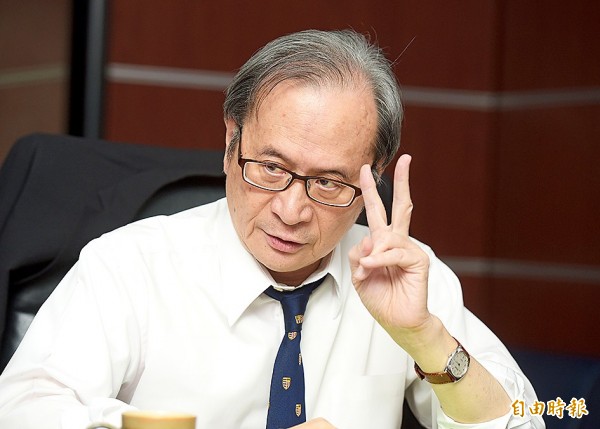《TAIPEI TIMES》Minister lays out path to nuclear-free Taiwan

Atomic Energy Council Minister Hsieh Shou-shing gestures during an interview with the Liberty Times (sister newspaper of the Taipei Times) on April 26. Photo: Huang Yao-cheng, Taipei Times
Atomic Energy Council Minister Hsieh Shou-shing in an interview with ‘Liberty Times’ (sister newspaper of the ‘Taipei Times’) staff reporters Jennifer Huang and Yang Mien-chieh clarified the cause of an emergency shutdown at a nuclear power plant in March, and said that the government is committed to its goal of achieving a ‘nuclear-free homeland’ by 2025
/
Liberty Times (LT): The tripping of the second reactor [at the Guosheng Nuclear Power Plant in New Taipei City’s Wanli District (萬里)] following its reactivation on March 27 has led to questions about nuclear safety. In your opinion, is the reactor safe to reactivate?
Hsieh Shou-shing (謝曉星): First, the term “reactivation,” commonly used in conjunction with the second reactor, leads to the mistaken assumption that the entire reactor is being reactivated, whereas it is simply being restarted.
The second reactor is on standby, not due to a major malfunction or because it is being phased out. Its standby status over the past 600 days is due to the surge arrester exploding within 35 minutes of the reactor being reconnected to the power grid. At the time, the fissile fuel rod had not been inserted, and the incident should not be considered a nuclear safety incident.
In the latest incident, Taiwan Power [Taipower, 台電] had followed the procedure to restart the reactor, and the council had approved the restart after extensive reviews involving 10 experts and a month-long review process. The application for the restart was approved after ensuring that nuclear safety standards were met.
Among the tests that were run prior to the restarting of the second reactor was the condition that it had to successfully be connected to the power grid twice, as well as the calibration of more than 10 pieces of equipment.
The trip that occurred in the second power grid connection, as Taipower explained it, was due to Taipower having changed the control system from analog to digital — such changes were not legally required to be reported to the council, as it was not vital to nuclear safety systems — to provide better and more reactive protection.
Upon re-engagement to the power grid, the system read the parameters for steam pressure as abnormal due to the lack of optimization of the setup, causing the reactor to engage the safety mechanism and “trip-stop” the entire reactor.
As the steam pressure system is legally not considered a system directly affiliated with nuclear safety, the trip is not considered to be a nuclear safety incident.
This goes to show that, despite the 600-odd days the second reactor spent in standby, its automated security functions are still in prime condition, which, in some sense, is a good thing.
However, the council has decided to err on the side of caution, as there is no telling when electronic systems could act abnormally.
We have asked Taipower to locate the original manufacturer of the steam pressure system to make adjustments, and have tasked more experts to initiate a three-stage review to isolate and identify the cause of the trip, and find ways to upgrade safety functions.
The council has demanded that Taipower conduct reactor transient analysis to further ensure that the reactor is stable.
The council will be implementing a higher standard with the upcoming review that would take up to two months, which would delay the restarting of the reactor to next month at the latest, as Taipower had, on April 10, tendered its application to restart the reactor.
The council’s foremost job is to ensure the safety of nuclear power. Everything in our power will be done to ensure safety and minimize risk. Information on nuclear power plants will be made public as much as possible, and we will attempt to approach our job of ensuring nuclear safety from the perspective of the public.
LT: Some people claimed that the restart of the second reactor spells the failure of the government’s “nuclear-free homeland” policy. Has there been a shift in how the government is approaching the policy?
Hsieh: It must be made clear that the second reactor at the Guosheng Nuclear Power Plant is legally applying to be restarted within its given commercial license, and as such, as long as it meets all nuclear safety standards as dictated by law, the council has to approve its restart.
This is a completely different issue from President Tsai Ing-wen’s (蔡英文) administration’s nuclear-free homeland policy. It is Taipower’s legal right to operate the Guosheng Power Plant within the time frame of its commercial license. Taipower’s capability to retire the plant as dictated by its license is the only caveat for a legal transition to the administration’s nuclear-free homeland policy by 2025.
Such policies have been broached by the Chinese Nationalist Party (KMT) as well, showing that this is an expectation that transcends political boundaries and is truly the wish of the public as a whole.
The Jinshan Nuclear Power Plant [in New Taipei City’s Shihmen District (石門)] is in its second phase of environmental assessment and is expected to begin undergoing the retirement process by the end of this year, to be completed by 2043.
The Guosheng plant is to tender its plans for its retirement next year — the retirement process would begin in 2021 and would conclude by 2046.
The Ma-anshan Nuclear Power Plant [in Pingtung County’s Hengchun Township (恆春)] is to tender its retirement plan by 2021 and conclude the retirement of the plant by 2049.
The government has clearly stated that in 2025, there will be no nuclear power in the nation, and that goal remains unchanged.
LT: Some people have suggested activating the Fourth Nuclear Power Plant [in New Taipei City’s Gongliao District (貢寮)] to mitigate air pollution. What are your thoughts on the issue?
Hsieh: The Fourth Nuclear Power Plant was panned as having been cobbled together. Its [construction began] nearly two decades ago. I do not think there is any precedent in the world in which a nuclear power plant that old was activated for the first time.
Aging components and rust damage would most certainly make starting the plant a tremendously difficult task. I do not think people will go for that option, when the Japanese [Fukushima Dai-ichi] nuclear disaster is still fresh in their minds.
The Fourth Nuclear Power Plant’s construction is unfinished. It will take a long time for Taipower to inspect the plant and evaluate it for de-mothballing. Plant evaluation and inspection by the council and Taipower will take a year at the very least. It will take many more years to complete the construction, authorize the plant for operation and to start it.
In contrast, the government’s agenda for a nuclear-free homeland by 2025 has been written into law, and the implementation date is legally binding. Starting the Fourth Nuclear Power Plant imposes steep costs and safety risks, and for what? Two or three years of power generation?
Taipower has already signed the agreements to hand over the plant’s 41,744 fuel rods to the US, with deliveries scheduled from next month to 2020. We are selling the unspent fuel rods for a profit. US manufacturers will process the rods after taking them apart, and will sell them to other nations.
This program would reduce Taipower’s maintenance expenditures by NT$100 million [US$3.37 million] per year. Moreover, the facilities of the Fourth Nuclear Power Plant could be utilized after its conversion into a mixed-type power-generation complex.
LT: Taiwan has no experience in decommissioning nuclear power plants, and dealing with radioactive waste would be a greater challenge. What does the council plan to do?
Hsieh: The decommissioning of the Jinshan Nuclear Power Plant will start by the end of the year. We will have to shut down the reactor, deal with the used fuel rods — among other high-level and low-level waste — and decontaminate the facilities.
Globally, more than 100 nations have decommissioned nuclear power plants or are in the process of doing so. We will be able to utilize their experience. Additionally, Taipower has drafted its own plan, which is currently undergoing an environmental impact study.
Handling radioactive waste is the greater challenge. Civic groups have said that we, as a nation, should be responsible for our own radioactive waste. As a matter of fact, it is unlikely that a foreign entity will be willing to take that out of our hands.
The Ministry of the Interior’s nuclear-free homeland task force has been working across departmental lines to find a suitable site for waste disposal. We believe that by 2025, there will be a central storage facility for the nation’s radioactive waste, including the high-level and low-level waste that is currently stored on Lanyu (Orchid Island, 蘭嶼).
Switzerland and the Netherlands have small high-level radioactive waste storage facilities at nuclear safety or research institutes in the suburbs. Many nations have built interim waste storage facilities at the site of former plants.
On Lanyu, the radioactive waste was buried in storage trenches. Japan later adopted a similar approach. The US has land to spare and used its deserts for storage trenches.
More recent storage facilities, like the one built in South Korea, are of a silo-type design, where the waste is buried in shafts 20m or deeper and sealed by concrete in a solid block. This is significantly safer and we are keeping an eye on these designs.
When disposing high-level radioactive waste in a rock formation, granite is one of the better choices. More then 10 percent of Taiwan’s geological bedrock is granite. However, this method remains controversial around the globe. Nobody likes living near a radioactive waste storage facility, yet everybody wants electricity. We need time to educate the public and establish trust.
The decommissioning of the Jinshan Nuclear Power Plant, from cooling the fuel rods to removing them, would take seven to eight years. As we weigh our options for a final storage and disposal facility, Taipower would also prepare an interim facility for their short-term storage.
Translated by staff writers Jake Chung and Jonathan Chin
新聞來源:TAIPEI TIMES
















